Bell tents and cabin tents can enhance your camping (or glamping) experience.
I’ll be the first to admit, it took me a while to convince myself that bell tents are more than just gimmicky “glamping” tents.
I’ve turned the corner a bit on them with more experience, but I still find cabin tents to be much more practical than bell tents.
Cabin-Style Tents: A Quick Note
I refer to cabin-style tents as rectangular tents using side support poles and tension rods to form the structure. Springbar invented this design. It’s like the “Kleenex” of tissues.
Four popular brands make these tents now. Springbar obviously refers to them as Springbar. Kodiak uses Flex-Bow. White Duck calls theirs a cabin tent and uses the name Prota. Then Teton Sports refers to theirs as cabin-style and calls it Mesa. All four of these use the same basic design.
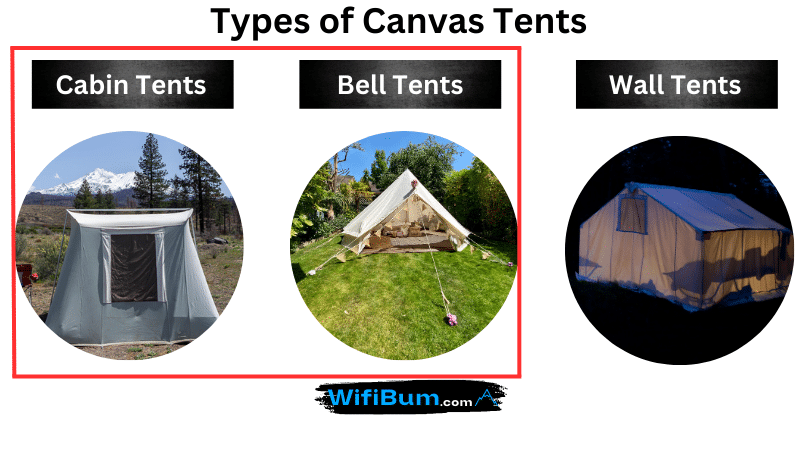
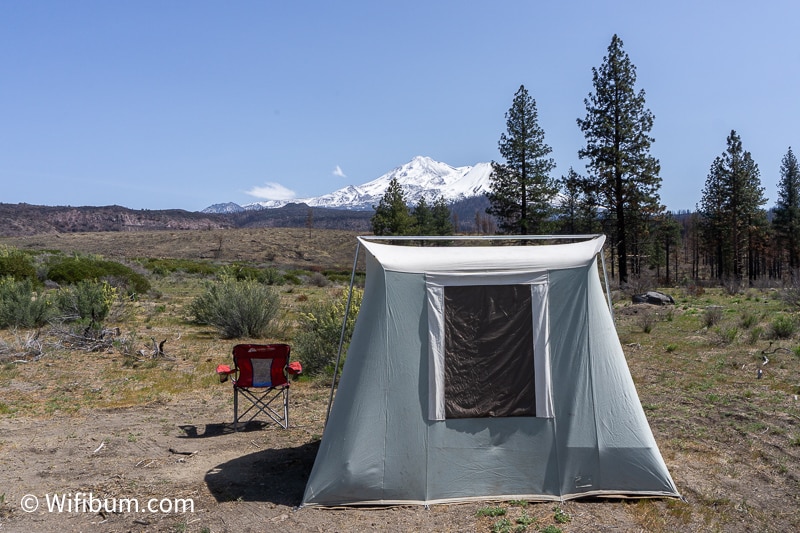
Bell Tent vs Cabin Tent: Which Is Better?
In my opinion, most outdoor folks will find cabin-style tents to be much more convenient and a better all around tent.
While bell tents have their moments to shine, they are not practical for most camping trips. You can view White Duck Outdoor bell tents here.
First, I’ll start with when to use a cabin tent over a bell tent. Then I’ll flip it around and give you the best times to use a bell tent over a cabin tent.
When to Use a Cabin Tent Over a Bell Tent
Always.
Kidding, but not really.
If you’re going to have one canvas tent in your outdoor gear collection, it should be a cabin tent.
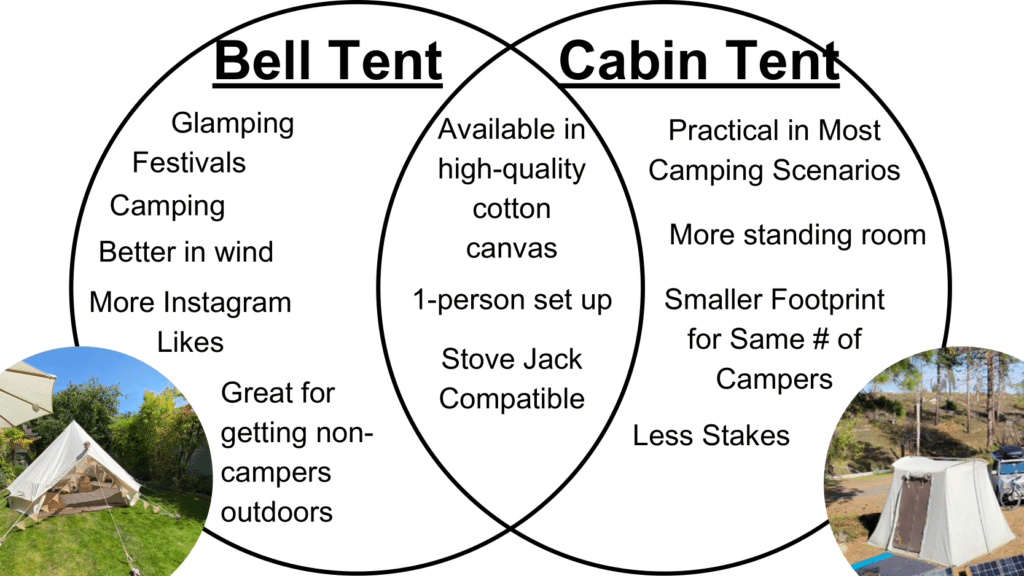
Why Cabin Tents are Better than Bell Tents
Cabin Tents Have Smaller Footprints
In a cabin-style tent, you will have more useable indoor space in a smaller footprint compared to similar-sized bell tents.
Bell tents require guy lines to be staked out away from the tent making them an issue in smaller campsites.
A 10×10 cabin tent is 100 square ft of interior space. They can sleep 3-4 comfortably with room for gear.
A 10ft diameter bell tent has ~79 square ft. Then guy lines need to be staked out 5ft around the circumference of the tent, essentially doubling the footprint of your tent. And this sized tent is recommended for 1-2 people.
To fit the same amount of people in a bell tent as a 10×10 cabin tent, you’d probably have to go a size up to the 13ft diameter bell tent. This gives you 133 sq ft, but takes up a huge amount of space.
Group Camping and Campsite Selection
Campsites are typically squares and rectangles making it easier to fit cabin tents.
If you bring a bell tent on a group camping trip, you will need a huge camping area. This is also true for large cabin-style tents
Paid Camping Cabin vs Bell Tents
Paid campgrounds are designed for traditional, rectangle and square tents that suit a cabin style tent better than a bell tent (however, large cabin tents may run into a similar issue).
Bell tent campers will likely need to reserve a group site vs an individual site to have enough space.
Camping on Public Lands with a Bell Tent
95% of my camping is done on public lands. You don’t often run into nice wide-open campsites that are unoccupied by RVs or other campers.
I primarily use a 7×9 canvas tent and there have been many areas where I would have been SOL with a 10×10, let alone a 13′ bell tent.
So, if you go on a group trip and want to bring the bell tent, you’ll have to arrive first to get the largest spot available and have your friends set up around you.
In addition, you must be an experienced camper to plan free camping trips that have enough space for a large bell tent. Previous experience will help you know what areas have larger clearings than others.
Having a smaller footprint is an advantage and can help get better campsites.
Cabin Tents Have More Standing Room
If you’re under 6’3″ you can stand ANYWHERE inside 10×10 cabin-style tents. I can even stand in the 7×9 tents as the ceilings to up to 6′ 3′ in the middle and taper to around 6′ at the walls.
In a bell tent, your standing room is limited to the inner area as the tent ceiling tapers down to the walls.
Cabin Tents Have More Useful Space
In cabin style tents, the walls are squared, meaning you can fit beds and tables against the walls and you’re not losing any space.
My gear bins are rectangular and fit perfectly in the corner without wasting other space.
In a bell tent, if you want to set up a table, you might have to set it off the walls a bit so that you have enough height to make it useful.
Staking a Bell Tent vs Cabin Tent
In both style of tents, you need to stake them down properly in order for them to function.
Cabin tents get their structural integrity from the tension of the poles.
Bell tents structural integrity comes primarily from the guy lines staked properly, not the ground cover stakes. It’s important to think about that as you’re looking for an idea place to set up.
It’s a pain in the butt for any canvas tent.
In a common 10×10 canvas cabin tent, this involves hammering down 14 stakes, maybe 16 for an awning.
If you want it to handle intense weather, 12 inch stakes are the way to go.
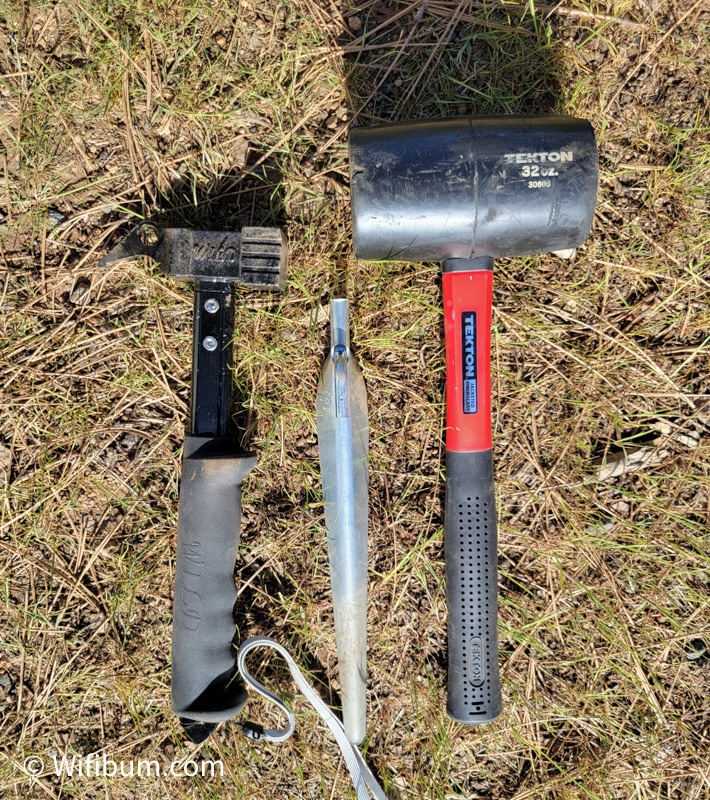
A similar sized Bell Tent will require about 24 stakes. Bell tents typically include smaller stakes than those that come with a cabin-tent.
This means it looks a lot easier when they are setting them up.
However, take those stakes to a windy festival and you’ll have an issue.
High-quality 12-inch stakes cost $4 to $6 each so if you’re taking it to a festival, you’ll want to budget in replacement stakes or use drillable lag screws.
Almost all the videos I see of bell tents are setting up in a nice grassy backyard. This is not typical camping terrain.
Trip Wires, EVERYWHERE for Bell Tents
Classic bell tents will have around 12 guy lines around the tent. If you’re car camping, you make plenty of trips to and from the car where you’ll have to avoid them.
Cabin Tents Are Better in Warm, Buggy Weather
Cabin tents are available with 4-full sided venting options. This is great in summer camping because you can create airflow without letting the bugs in.
Bell tents have the amazing option of dropping the walls to keep the tent cool, but it’s not great for mosquito season. If the bugs are out, bell tents lack summer ventilation.
For example, the popular White Duck Regatta only has a few small windows near the bottom. The cabin-style White Duck Deluxe have 4 sided windows.
There has to be an exceptional reason to switch to a bell tent like the popular White Duck Regatta.
Similarties
Assuming they are both quality canvas tents, both will have the benefits AND drawbacks of canvas.
They will keep you dry, handle wind, and be spacious.
When to Use a Bell Tent over a Cabin Tent
While I love cabin tents, there are occasions where bell tents are superior.
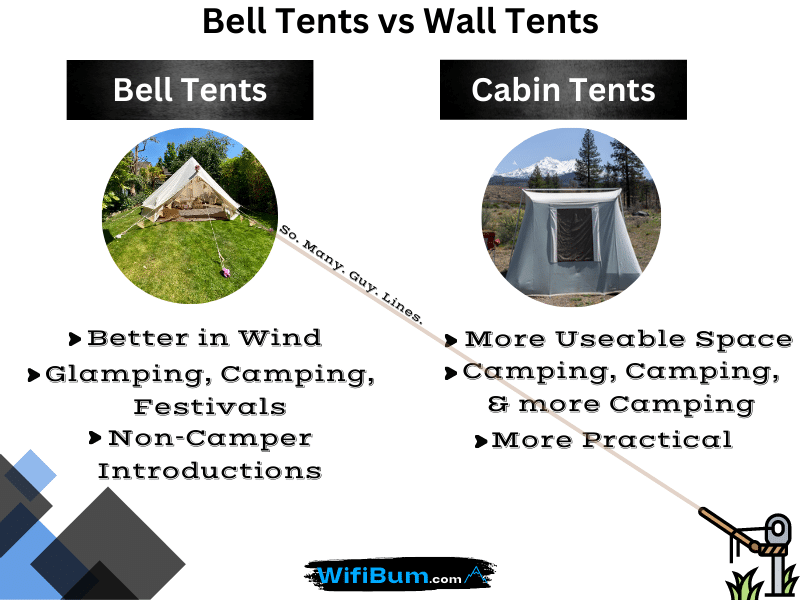
Spacious, Flat, Open Areas
Bell tents are best used in large, flat, open areas.
You need to account not only for the large tent footprint (typically starting at 10ft in diameter and increasing), but also the additional room for guy lines that are used to tie down the canvas to the ground.
Bell Tents vs Cabin Tents in Windy Conditions
Those large, flat, open areas I mentioned above can be notorious for windy conditions and even intense winds that could destroy a cabin tent while a bell tent will remain standing.
After about 35mph or more, you should probably collapse most cabin tents, and some even at 25mph to avoid potential gusts while you’re away from camp.
Many bell tent companies claim they can handle 50mph or more.
These large open spaces (think Burning Man) can have very intense winds. Bell tents can handle wind better due to their advantageous shape compared to cabin tents.
Festivals, Glamping and Party Camping
Bell tents are great tents for festivals, glamping, and party camping.
In fact, that’s why they are sometimes referred to as “festival” tents. They do well in this terrain because they are easy to stake down without obstacles in the way.
They also are aesthetically pleasing and can be decked out with lights, carpets, and more.
One of my favorite bell tent experiences was a glamping / party camping trip. We went camping for some star gazing and some light hiking.
The 2nd evening, it started raining pretty hard and like 10 of us crammed into one bell tent. We were all able to sit around the circumference and hang out in a dry, comfortable space.
Solo Winter Camping with a Bell Tent
This is an odd one, but hear me out.
The smallest cabin-style canvas tent can be modified for a wood-burning stove is 10×14.
Setting up a 10×14 by yourself is a tough task when you have to lift the sides up for the final step.
The smallest bell tent I found that has a stove jack and seems safe to use is the White Duck Outdoors 10′ Regatta Bell Tent. At ~51lbs, it’s much lighter than an 82lb Classic Jack cabin tent.
Bell Tents are Great for Non-Camper Introductions
Bell tents are a great way to introduce non-campers to the camping way of life.
You can really make it a homey experience and get them hooked by rolling out the red carpet, literally. There are tons of bell tent carpeting options to create an unforgetable atmosphere.
If you have small kids, it’s great for them to be able to run around inside and play. The tent will look like a castle to them.
If there is a guy or gal in your life that doesn’t share your enthusiasm for camping, this could be a great way to ease them into the camping experience.
Similarities of Bell Tents and Cabin Tents
There are many similarities between bell tents and cabin tents.
The best ones are made out of cotton canvas and typically treated with a variety of agents to make them waterproof, antifungal, and/or fire retardant.
Both will have the same benefits of canvas tents vs traditional nylon and polyester tents. Since that article covers it in detail, I won’t cover it here.
Bell Tent vs Cabin Tent: Location, Location, Location
I believe bell tents and cabin tents tend to be at odds with each other because it really depends where you spend the majority of your time camping to determine which is best.
Someone in the Pacific Northwest camping in national forest and wilderness will balk at a Bell tent. The footprints are simply too large for 99% of available campsites.
However, if you’re hanging out in the vast, relatively bare, BLM land of Southern Utah, they make complete sense! The bell tents have ample space in deserts and can handle the crazy desert winds better.
Although, I wrote that last paragraph… I still find it difficult to find large patches of flat land even in desert terrain. There are still small vegetation to navigate around and you may have to walk away from the dirt roads carrying a big ass tent.
Cabin Tent vs Bell Tent: How Much Does it Cost?
Cabin tents and bell tents generally cost around the same amount, but favors cabin tents.
A quality cabin tent is the Kodiak 10×10 Flex-Bow cabin tent that sells around $650 with shipping. A quality bell tent is the White Duck 13′ Regatta Bell Tent is ~$760 with shipping.
Final Thoughts
In the past 5 years, bell tents have become increasingly popular and more accessible to campers.
Bell tent companies have some of the best content creation strategies of all in the canvas tent market.
When you google about canvas tents, you’re likely to stumble upon content from a bell tent company. They have a huge incentive to market their own bell tents to you and to make you forget about cabin-style canvas tents.
On the other hand, the two primary companies in the cabin tent world, Springbar and Kodiak, use zero content marketing outside of Instagram.
Hopefully, this helped you understand some of the differences in uses between cabin tents and bell tents.
